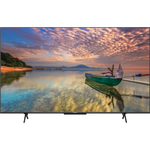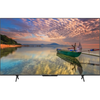A comparison of specs, key information, reviews, and best pricing from top retailers
Last updated -- hours ago | Report incorrect information
What we think

The PerfectRec TV team Learn more
Updated January 10, 2024·
If you're looking for a TV that's more budget-friendly and delivers better overall picture quality, especially for movies and gaming, the Hisense U6H could be a strong choice. However, it may not perform as well in brightly lit rooms compared to the Samsung Q60C. The Q60C, while more expensive, offers better sound quality and is newer, but it doesn't have the stronger contrast and local dimming features that the U6H has. If a brighter room performance and the addition of voice command features are important to you, consider the Samsung Q60C despite its higher price. Give Feedback
this description is based on the product variant with some specs and product variant with some specs. At the time of writing, the variant with some specs cost some dollars and the variant with some specs cost some dollars.
Advantages of the Hisense U6H (LCD)
- Good for bright room
- Good for dark room
- Good for movies & TV
- Very good for news, talk, & other TV
- Very good for cartoons & animation
- Good for upscaling
Advantages of the Samsung Q60C (LCD)
- Very good motion processing
Key differences
Picture Quality
7.7


6.0
7.38/10
CONTRAST
5.55/10
7.6/10
COLOR VOLUME SCORE
7.3/10
LED FALD
PANEL TYPE
LED
VA
PANEL SUB-TYPE
VA
The Hisense U6H (LCD) has good picture quality, while the Samsung Q60C (LCD) has only fair picture quality.
Movies & TV
7.7


5.5
7.38/10
CONTRAST
5.55/10
6.3/10
BLACK UNIFORMITY
2.9/10
7.5/10
UPSCALING
6.6/10
Yes
HDR10 SUPPORT
Yes
Yes
HDR10+ SUPPORT
Yes
Yes
DOLBY VISION SUPPORT
No
The Hisense U6H (LCD) is good for movies & TV, while the Samsung Q60C (LCD) is poor.
The Hisense U6H offers better contrast and black uniformity, which are crucial for a rich movie and cinematic TV experience, especially in dark scenes, whereas the Samsung Q60C's lower contrast and poor black uniformity can result in a less vivid picture with washed-out blacks. Furthermore, the U6H has more effective local dimming to enhance scene detail by adjusting brightness in specific zones, while the Q60C has subpar local dimming, making it less capable of providing depth and detail in varying lighting conditions.
Sports
6.0


6.5
2.5/10
MOTION PROCESSING
8.0/10
60Hz
REFRESH RATE
60Hz
8.7/10
INPUT LAG SCORE
10.0/10
7.5/10
UPSCALING
6.6/10
7.8/10
SDR BRIGHTNESS SCORE
7.9/10
Yes
HLG SUPPORT
Yes
The Samsung Q60C (LCD) and Hisense U6H (LCD) are both only fair for sports, though the Samsung Q60C (LCD) is somewhat better.
The Hisense U6H and Samsung Q60C both have poor response times which can affect motion clarity when watching sports. However, the Hisense has a slightly better handling of reflections and a wider viewing angle, which can be beneficial in a room with multiple viewers or where light reflections are a concern.
Gaming
6.2


5.7
5.8/10
RESPONSE TIME SCORE
5.2/10
8.7/10
INPUT LAG SCORE
10.0/10
2.5/10
MOTION PROCESSING
8.0/10
70.0/100
GAMING LOCAL DIMMING
30.0/100
7.1/10
GAME HDR BRIGHTNESS SCORE
6.1/10
The Hisense U6H (LCD) is only fair for gaming, while the Samsung Q60C (LCD) is poor.
The Hisense U6H provides a better gaming experience than the Samsung Q60C primarily because it has lower input lag, allowing for more responsive gameplay. Additionally, the Hisense has a higher response time score, resulting in less motion blur during fast-paced games.
Cartoons & Animation
8.4


7.5
7.7/10
COLOR GAMUT SCORE
7.3/10
7.6/10
COLOR VOLUME SCORE
7.3/10
7.8/10
SDR BRIGHTNESS SCORE
7.9/10
9.1/10
COLORS OUT OF THE BOX SCORE
7.8/10
7.0/10
GRAY UNIFORMITY
7.0/10
The Hisense U6H (LCD) is very good for cartoons & animation, while the Samsung Q60C (LCD) is good.
The Hisense U6H is rated higher for cartoons and animation because it delivers excellent colors out of the box and has a good color gamut, which means that the visuals are vibrant and accurate without needing adjustment. On the other hand, the Samsung Q60C is also good for animations due to its capable color performance but doesn't match the Hisense's out-of-the-box color quality.
News, Talk, & Other TV
8.2


6.8
7.8/10
SDR BRIGHTNESS SCORE
7.9/10
7.5/10
UPSCALING
6.6/10
The Hisense U6H (LCD) is very good for news, talk, & other TV, while the Samsung Q60C (LCD) is only fair.
The Hisense U6H typically shows better performance for news and talk shows due to its superior upscaling of lower-resolution content and its higher SDR brightness, which are very important for such viewing experiences. In contrast, the Samsung Q60C, while decent, falls short in these areas, as it doesn’t upscale as effectively and isn’t as bright, making the Hisense U6H the better option for those particular programs.
Bright Room
7.0


6.5
5.6/10
VIEWING ANGLE
5.3/10
7.8/10
SDR BRIGHTNESS SCORE
7.9/10
6.9/10
HDR BRIGHTNESS SCORE
5.7/10
6.6/10
REFLECTIONS SCORE
6.3/10
The Hisense U6H (LCD) is good for bright room, while the Samsung Q60C (LCD) is only fair.
The Hisense U6H has a higher contrast, which makes it better for viewing in bright rooms, and it also handles reflections well, despite its SDR and HDR brightness being just good and fair. In comparison, the Samsung Q60C, while having good SDR brightness, falls short with poor HDR brightness and significantly lower contrast, which means it's less suitable for bright environments.
Cost
$498


$749
$200
$400
$600
$800
$1,000
$1,200
The Hisense U6H (LCD) has a price of $498 and the Samsung Q60C (LCD) costs $749.

Let Us Help Find Your Perfect TV
Find your new TV
Give feedback
We’re constantly working to improve.
How the Hisense U6H (LCD) and the Samsung Q60C (LCD) compare to other TVs
Spec Comparison
| Hisense U6H (LCD) | Samsung Q60C (LCD) |
GENERAL | |||
|---|---|---|---|
| Price | |||
$498 | $749 | ||
Brand | |||
Brand | Hisense | Samsung | |
Release Date | |||
Release Date | June 3, 2022 | April 5, 2023 | |
Full name | |||
Full name | 65U6H | QN65Q60C | |
Screen Size | |||
Screen Size | 65" | 65" | |
Screen Resolution | |||
Screen Resolution | 4K | 4K | |
TV FEATURES | |||
|---|---|---|---|
Operating System | |||
Operating System | Google TV | Tizen | |
Sound Quality Score | |||
Sound Quality Score | 6.1/10 | 6.6/10 | |
NextGen Ready | |||
NextGen Ready | No | No | |
HDMI Ports | |||
HDMI Ports | 4 | 3 | |
Coax Ports | |||
Coax Ports | 1 | 1 | |
DISPLAY QUALITY SCORES | |||
|---|---|---|---|
Picture Quality Score | |||
Picture Quality Score | 7.7/10 | 6.1/10 | |
Bright Room Score | |||
Bright Room Score | 7.1/10 | 6.5/10 | |
Gaming Score | |||
Gaming Score | 6.3/10 | 5.7/10 | |
Movies & TV Score | |||
Movies & TV Score | 7.7/10 | 5.5/10 | |
Sports Score | |||
Sports Score | 6/10 | 6.5/10 | |
PHYSICAL | |||
|---|---|---|---|
Dimensions w/o Stand (H x W x D) | |||
Dimensions w/o Stand (H x W x D) | 33" x 57" x 3" | 32.7" x 57.1" x 1" | |
Dimensions with Stand (H x W) | |||
Dimensions with Stand (H x W) | 35.7" x 57" | 34.3" x 57.1" | |
Weight without Stand | |||
Weight without Stand | 41.2 lbs | Unknown | |
VESA Mount | |||
VESA Mount | 300 x 200 | 400 x 300 | |
DISPLAY | |||
|---|---|---|---|
Color Depth | |||
Color Depth | 10 bit | 10 bit | |
Black Frame Insertion | |||
Black Frame Insertion | Yes | Yes | |
Auto Low Latency Mode | |||
Auto Low Latency Mode | Yes | Yes | |
Contrast | |||
Contrast | 7.4/10 | 5.6/10 | |
Local Dimming | |||
Local Dimming | 6.5/10 | 4.1/10 | |
SOUND | |||
|---|---|---|---|
Speaker Setup | |||
Speaker Setup | 2.0 | 2.0 | |
Speaker Power | |||
Speaker Power | 20 W | 20 W | |
Dolby Atmos | |||
Dolby Atmos | Yes | Yes | |
DTS:X | |||
DTS:X | Yes, Bypass only | No | |
Shopping
Hisense U6H (LCD)
See more
Dig into reviews and images
Tom's guide
Matthew Murray | March 2023
"A budget TV that exceeds expectations. (...) For a TV that costs as little as this one does, its brightness and color are above-average (...) The U6H may not get quite as bright as its splashier siblings, but for its class, it fares pretty well. (...) As far as input lag, the U6H is an impressive performer. (...) Costing less than most of its direct competitors, and matching or bettering them in several key areas, it’s an irresistible value proposition. (...)"
Get a great deal on the Hisense U6H (LCD) or the Samsung Q60C (LCD)
About Hisense
Hisense, a Chinese TV manufacturer, entered the US market in approximately 2011 and has since acquired TV divisions from various companies such as Toshiba, Sharp, Hitachi, and NEC. Currently ranking as the fourth largest vendor in terms of sales volume, Hisense aims to capture a wide range of TV budget segments. They offer exceptional value with TVs that often outperform their competitors at similar price points, making them a compelling choice for consumers. In the US, they use Google TV as their smart TV software which provides the largest app selection and a very modern user interface, however it is not as user friendly as the software from other vendors.
About Samsung
Samsung, a South Korean electronics manufacturer, holds the title of being the largest global TV vendor in terms of units sold. They offer a diverse lineup of TV products that cater to various budget ranges. A notable achievement in recent years is the development of Quantum Dots, a technology that enhances color reproduction, resulting in richer and more vibrant hues. Samsung TVs are well-regarded for their high manufacturing quality and user-friendly software, making them an excellent choice for consumers seeking an intuitive viewing experience.
Give feedback
We're constantly perfecting our model
TV guides you might be interested in
More comparisons for you
Compare Hisense U6H (LCD) vs. Hisense R6G (LCD)
VS
Compare Hisense U6H (LCD) vs. Hisense U6G (LCD)
VS
Compare Hisense U6H (LCD) vs. LG UQ7570 (LCD)
VS
Compare Samsung Q60C (LCD) vs. Vizio V-Series '22 (LCD)
VS
Compare Samsung Q60C (LCD) vs. Vizio M-Series (LCD)
VS
Compare Samsung Q60C (LCD) vs. Amazon Omni Series (LCD)
VS
FAQs
FAQs about TVs
Why trust us
This information was produced and vetted by the PerfectRec TVs team. We are a product research and recommendation organization that meticulously reviews and evaluates the latest TV information and makes it digestible for you.
By the numbers
385
TVs evaluated
33,110
TVs stats compiled
21
Proprietary TVs ratings developed
121,830
Recommendations made
18,275
Consumer hours saved
About the TV team
Joe Golden, Ph.D
CEO and TVs Editor
Joe is an entrepreneur and lifelong electronics enthusiast with a Ph.D in Economics from the University of Michigan.
Jason Lew
Staff Expert & Software Engineer
Jason is a staff expert and software engineer that has been making laptop recommendations for 7 years and moderates one of the largest laptop subreddits.
Chandradeep Chowdhury
Staff Expert & Software Engineer
Chandradeep is a staff expert and software engineer and expert in televisions and monitors. He’s been making monitor recommendations for ten years.
Jaime Roldán
TVs Expert
Jaime is a Colombia-based TV expert. He is an electronics engineer with 8 years of experience in the telecom sector and has been making TV recommendations for 12 years.







